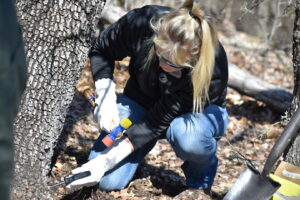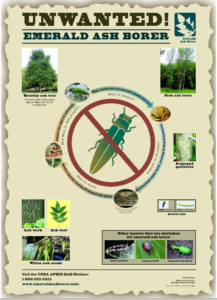Texas Trees Foundation Urges Immediate Action from the City of Dallas Regarding Ash Tree Infestation
The Emerald Ash Borer (EAB), an invasive, wood boring beetle that targets ash trees, is posing a substantial threat to Dallas’ urban forest, on both public and private land. EAB kills unprotected ash trees within 2-3 years of infestation and can eliminate entire untreated stands of ash trees within 10 years. Yesterday, the Texas A&M Forest Service confirmed the presence of EAB in Dallas County.
Texas Trees Foundation’s 2015 State of the Dallas Urban Forest Report found that at least 13.1 percent of all trees in the city are ash, which accounts for an estimated population of nearly 2 million ash trees across Dallas. In the Great Trinity Forest, 23% of the tree population is at risk.
An assessment of the condition and location of the ash trees in the City of Dallas public property, including the Trinity Forest, is necessary for a successful EAB mitigation strategy. Additionally, private homeowners/landowners are crucial to effectively combating EAB.

The most effective mitigation strategy for an EAB infestation is to slow the spread using a SLAM approach (SLow Ash Mortality). This strategy includes monitoring ash trees for EAB, injecting ash trees with systemic insecticide, removal of only low-quality ash trees, following quarantine regulations and replacing ash trees with different tree species to diversify the urban forest.
Janette Monear, Texas Trees Foundation CEO/President, “urges the City to utilize the SLAM strategy, by immediately conducting a complete tree inventory of publicly owned lands in the City of Dallas (Dallas UFMP, 2021). This information can quickly be used to identify where high value ash trees (vigorous ash trees) are located for monitoring and systemic insecticide injections. This approach will slow the spread of EAB by reducing population size of the insect, preserving valuable ash trees of differing age and size, protecting Dallas tree canopy cover, and minimizing public costs overtime.”
Once the inventory reveals where and which ash trees should be injected, a rotational, annual treatment, of a required percent of the ash population, on City of Dallas public property should be agreed upon, to protect 99 percent of the City of Dallas ash tree population, on Dallas public lands.
“EAB poses a serious threat to Dallas’s urban forest; especially the Great Trinity Forest where most of the City’s ash trees are found. We can mitigate this threat through a strategic, integrated, research-based approach, which is more financially and environmentally effective then just removing all the ash trees or letting them die.” said Rachel McGregor, Urban Forestry Manager with the Texas Trees Foundation.
In 2015, the city’s ash population was valued at $890.3 million, based on its structural value and ecosystem benefits.
Cities that delay action or rely on a ‘removals-only’ approach may be overwhelmed with trees posing an unacceptable public risk. The SLAM strategy will not only save money, but it will also reduce liabilities.
Residents who have ash trees are advised to take the following steps:
- Confirm/identify if they have ash trees on their property
- Engage an ISA Certified Arborist to assess their ash tree and help them decide a course of action. https://isatexas.com/for-the-public/find-an-arborist/
- If systemic injection treatment is desirable, hire a certified arborist with a current TDA pesticide applicators license. The most effective treatment is with a systemic insecticide injection of Emamectin Benzoate (this product is a restricted use pesticide).
- Monitor trees for EAB – if the tree has been systemically injected with Emamectin Benzoate, the treatment will last 2-3 years (see more on signs and symptoms of EAB using the link below).
- If ash tree removal is necessary, be sure to comply with Texas Department of Agriculture EAB quarantine regulations (see more on regulations using the link below).
For more information about the Emerald Ash Borer and Texas Trees Foundation’s recommended strategic approach against EAB infestation, please contact Rachel McGregor at rachel@texastrees.org
- For more information on EAB in Texas, please visit http://texasforestservice.tamu.edu/eab/.
- EAB photos and resources can be viewed and accessed at http://ow.ly/LIJi30lbBxz.
- For information from TDA on EAB quarantine, visit https://texreg.sos.state.tx.us/public/readtac$ext.ViewTAC?tac_view=5&ti=4&pt=1&ch=19&sch=Z&rl=Y
- or https://texasagriculture.gov/RegulatoryPrograms/PlantQuality/PestandDiseaseAlerts/EmeraldAshBorer.aspx.
- To report emerald ash borer, please call 1-866-322-4512.

